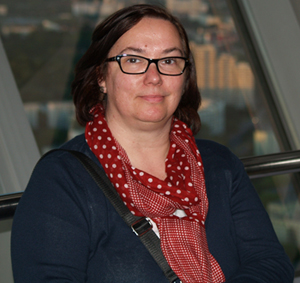
Loranda Miletic
Teacher Loranda Miletic was instrumental in the creation of innovative and highly popular Croatian-language lessons that teach students about the Holocaust through testimony.
Miletic has worked as a history teacher at primary and secondary schools for many years. Since 2004, she has been Senior Advisor for History Education at the Education and Teacher Training Agency (ETTA) in Croatia, responsible for organizing professional development, providing professional advisory support to teachers, conducting professional examination for teachers beginners, and supervising implementation of the History curriculum.
Of all her tasks, the one she enjoys the most is the promotion of teaching about the Holocaust in the Republic of Croatia, Miletic said. This includes organization of seminars for teachers on regional and national level, development of additional teaching materials, and participation in international projects. She is a member of the Croatian delegation at the International Holocaust Remembrance Alliance (IHRA).
Miletic was appointed coordinator of a joint project between the Ministry of Education, Science and Sport of Croatia, USC Shoah Foundation – The Institute for Visual History and Education and ETTA in 2006 to develop a new educational product for teaching Croatian students about the Holocaust. While many seminars and workshops had been conducted in the past, there was a need for a “more powerful and modern“ way to teach the local Croatian experience. USC Shoah Foundation’s several hundred testimonies of Croatian survivors, rescuers and witnesses made it an ideal source to incorporate into the project.
The seven lessons, each concerning a different topic such as “The suffering of women and children in the Jasenovac concentration camp“ and “Collaboration, conformism, confrontation“ are constructed as modular, stand-alone lessons with some overlaps and connections. Besides the video clips, each lesson includes detailed instructions for the teachers, handouts and worksheets, additional lesson material, and a term glossary. The lessons are intended for students in elementary and high school as well as vocational (adult) school.
Video is an engaging educational medium for today’s students, and one to which they readily respond, Miletic said. Whle it is important for students to connect with survivors, watching a testimony is the next best thing to meeting the survivor in person.
“When watching testimonies, students see for themselves a real face, a real voice, helping them understand that behind each statistic and each fact, is a person,“ Miletic said. “Students can develop an immediate and intimate bond with the person on the screen and become personally and emotionally affected.“
It is important that students watch testimony not only to hear survivors describe the tragedies of the Holocaust but also to learn about their everyday lives, traditions, friendships and families, in which questions of justice, labeling and scapegoating often emerge. These are issues adolescents confront int heir daily lives, she noted.
“Visual history testimony, when combined with a standard written curriculum and provided with the proper historical context, is an unparalleled primary source material for teachers and educators. It can be used in a classroom setting to get young people to think about their behaviors and biases today, and to inspire dialogue about their role in the history that is currently being made,“ Miletic said.
The lessons represent the most comprehensive multimedia resource about Croatian World War II history and the fate of Jews in Croatia ever created, Miletic said. The lessons have been presented and disseminated at two national and five regional teacher training seminars. It was also distributed to 800 schools across the whole country, to be used within lessons of history, ethics, Croatian language and religion.